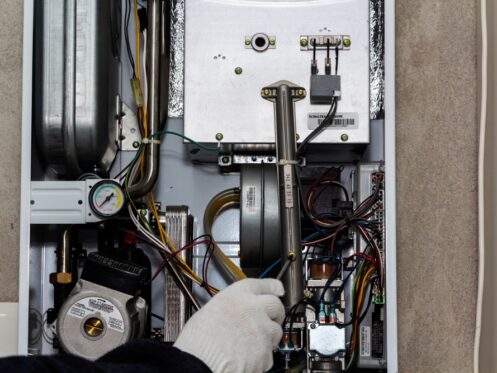Denver, CO has cold weather with quite a bit of snow each winter, but that doesn’t necessarily mean you want your heater to stay on 24/7. If your heater or furnace won’t turn off, it can be a little bit concerning. Fortunately, the team at High 5 Plumbing, Heating, Cooling, and Electric has some helpful insight into why this issue might occur. Here are eight reasons why your heater may fail to turn off, and what you can do to fix it.
1. Thermostat Malfunction
A malfunctioning thermostat could prevent your heating system from turning off. In most cases, this problem is due to the thermostat reading the indoor temperature incorrectly but it may be something as simple as a dead battery. There might also be a bad connection somewhere in the thermostat control board.
To remedy the issue, start by removing the thermostat’s battery cover and replacing the old batteries with fresh ones. Make sure the thermostat is set to “heat” or “auto” and that the temperature is set below the room temperature, which should trigger the heater to turn off. Thermostats that are hardwired should have secure connections to work properly, so verify that all wiring is intact and tightly connected.
2. Restricted Airflow
A dirty or clogged air filter can hamper your heater’s airflow, causing it to remain on despite the setting. Clogged or blocked ductwork may also be the cause of restricted airflow. When airflow is restricted, it causes the heater to work harder, making it more difficult to maintain a consistent temperature.
The best way to address this issue is to inspect your air filter and if it’s dirty, replace it with a new one. Check your ductwork to look for any signs of dirt or major blockages. You can also call the High 5 team if you need a duct inspection and cleaning. Once airflow is restored, your heater should turn off when it’s supposed to.
3. Heat Anticipator Adjustment
If your furnace won’t shut off even when the thermostat is off, it may be related to the heat anticipator. This thermostat component allows the furnace to continue to produce and distribute heat for a short time until the heat exchanger cools down. When the heat anticipator is timed correctly, the temperature increases until it reaches the pre-set temperature just after the burners shut off.
You may need to adjust the heat anticipator to get your furnace to turn off again. Remove the thermostat cover, locate the anticipator, and move the lever closer to the “LONGER” setting by just one mark. Test your furnace and see if it shuts off, and if not, adjust it by one mark again. Repeat this step until your furnace shuts off when it’s supposed to.
4. Misaligned or Dirty Flame Sensor
When the flame sensor gets dirty or when it’s out of alignment, it can’t detect the gas flame, leading to short-cycling or keeping your furnace on constantly. Corrosion, dirt, and dust are common issues that can easily clog the flame sensor.
Locate the furnace flame sensor and inspect it for signs of dirt and buildup. Turn your gas furnace off, then gently wipe the flame sensor with a soft cloth until it’s clean.
5. Faulty Limit Switch
The limit switch is a safety device that monitors the internal temperature of your furnace or heater. It shuts the heater down once the temperature goes above a safe level to prevent overheating. However, if this important component is malfunctioning, your heater might not be able to turn off. This usually occurs due to age or just due to normal wear and tear.
The limit switch is usually a small button or switch located on the heater panel. Reset the switch by turning off the heater at the circuit breaker, and wait a few minutes before you turn it back on. You can also gently push the limit switch button until it clicks and releases to reset it. If this doesn’t work, it may also need to be replaced by a professional HVAC technician.
6. Electrical Control Board Issues
The electrical control board controls and coordinates your heater’s operations to ensure that everything is done in the correct order. When there is a loose connection or the component is faulty, there’s a good chance that your furnace or heater won’t shut off.
Start by making sure the circuit breaker for your heater hasn’t tripped and reset it if you need to. Next, visually inspect the electrical control board to look for signs of corrosion or loose wiring, and check for a blown fuse. When all else fails, contact the experts at High 5 to troubleshoot and repair or replace your heater’s electrical control board.
7. System Overheating
An overheating system is a serious issue caused by any number of factors, including dirty ductwork, clogged air filters, a clogged heater valve, a defective check valve, a faulty relay, or thermostat issues.
Don’t take chances if your heating system is overheating. Call the High 5 team to inspect your heater and look for the cause, diagnose the issue, and make the necessary repairs.
8. No Maintenance or Inspection
Regular maintenance is key to protecting your heater and prolonging its lifespan. Make sure you schedule HVAC maintenance at least twice a year to keep your system running smoothly.
High 5 provides comprehensive HVAC maintenance services designed to keep your heater working all winter long. From thorough inspections that find problems early to simple air filter changes, we’ll make sure everything is working efficiently.
Issues With Your Heater? Contact the Team at High 5 for All Your Heating Repair Needs
If you’re having issues with the heater in your Denver, CO area home, trust the team at High 5 Plumbing, Heating, Cooling, and Electric. Thanks to our years of industry expertise, we’ll troubleshoot, diagnose, and repair the problem to restore comfort to your home as quickly as possible. Our team is standing by to help you, so contact us for service today!

